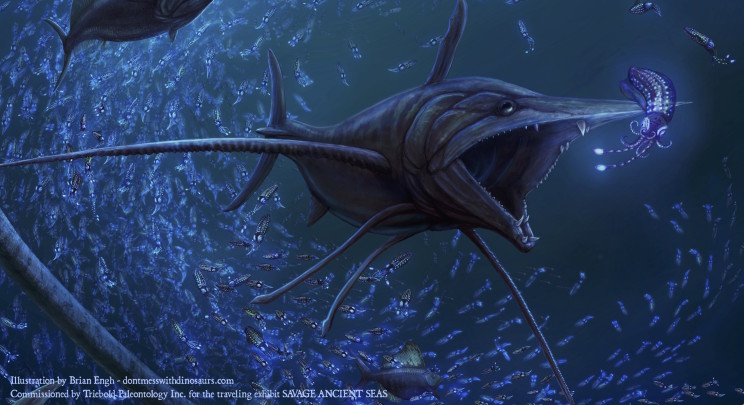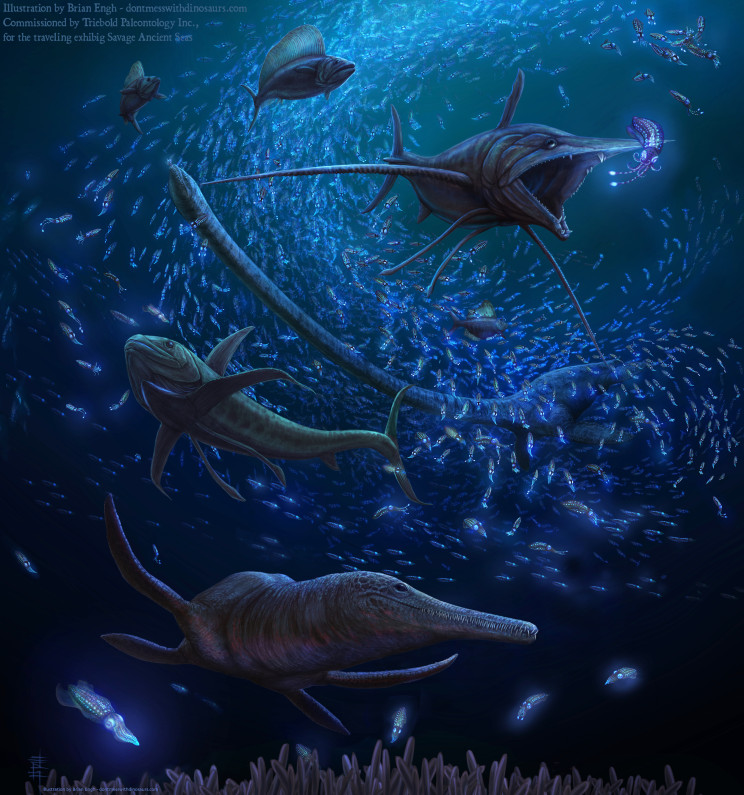Blade-winged monsterfish from the depths of prehistoric Kansas!
Way back in the age of the dinosaurs there was a diverse group of bony fish that evolved rigid fins tightly packed with mashed-together fin bones that they used to fly through the water in pursuit of a wide range of prey. This group is called the Pachychormid fish, and a new paper coauthored by paleontologist Anthony Maltese along with a shimmering bait-ball of other fishy researchers, explores the evolution of the pachychormids into numerous ecological niches by analyzing the distinctive shape of their specially adapted wing-like fins. The whole paper is open access, so if you want to take a deep dive into the intricacies of pachychormid fin evolution you can download the whole open access paper for free here!
In 2017 I had the pleasure of collaborating with Anthony on a bunch of artwork for the traveling exhibit Savage Ancient Seas by Triebold Paleontology Inc., some of which features these fascinating ancient fishes. We’re now finally releasing that art broadly online as it features two(!!) updated reconstructions of pachychormid fish – Protosphyraena (above) and Bonnerichthys (gulping below).
This was a particularly fun image to create because it features a bunch of animals from the Western Interior Seaway that all appear to have adaptations for feeding on small bodied shoaling prey, so we tossed them all together in one scene feeding on bioluminescent cephalopods! In our modern oceans it is not uncommon to see numerous species of predators feeding on dense aggregations of small squid, krill, or fish, so we thought it plausible to feature these cretaceous animals all existing in a similar ecological space as they assault a swarm of breeding cephalopods.
Arguably among the least recognizeable animals here are the pachychormid fish. This is in large part because their fossils are rare, and complete skeletons even rarer.
Bonnerichthys is fun because Bonnerichthys had ridiculously wide gulping jaws, big filtering gills, and reduced teeth. These features, all indicate that Bonnerichthys was an OG plankton eater – these 15+ foot long fish were gulping down clouds of lil’ snack organisms way before modern whales and whale sharks made it all mainstream. As a result of their generally chill-mode plankton-scooping lifestyle, they had broad wing-like fins well suited for gliding. From my paleoartist’s perspective Bonnerichthys is most accurately described as a dizzyingly big aquatic muppet / reaper of tiny souls that looks like it glided with unsettling ease out of the creator-spirit’s forehead and disappeared into the drunken cosmic midnight when She signed off on all the mesozoic fishes, even the ones the Forge Ogres put in there as jokes.
The other pachychormid featured in the art is called Protosphyraena. Protosphyraena’s teeth were oddly angled blades that seem to have projected slightly forward, like a horrible buck-toothed barracuda that no orthodontist would be dumb enough to work on. Protosphyraena’s beauty was on the inside… Somewhere. This sleek marauder had all the hydrodynamic signs of being fast as hell, with a set of narrow fins like the wings of a falcon and an overall body-plan strongly convergent with modern swordfish, right down to the sharp-n-pointy nose.
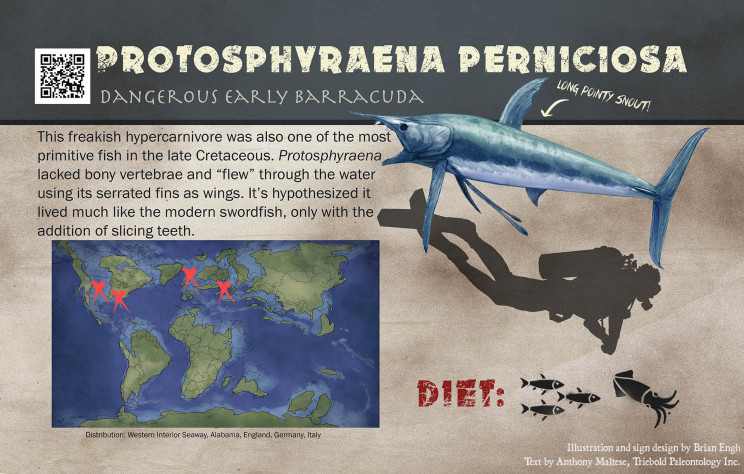
Basically if you had mystical ballista that launched 2m long fish at your enemies and you wanted to inflict THE MOST DAMAGE, you would want to load that ballista with Protosphyraenas. And yes there’s good reason to think that creepy witch-that-got-turned-into-a-tree nose would have stabbed the absolute murder out of stuff. As a general rule, If you see an aquatic animal with a big long stabby or slashy-looking nose, it probably looks that way because it’s for WRECKING UP gangs of smaller animals with frighteningly accurate underwater swashbuckling. Seriously though, WATCH THIS RIGHT HERE:
“But why bioluminescent squid?? Why not a shoal of schooling fish, like every other marine predator paleoart ever?” you quite reasonably inquire. Here are my reasons.
1) I grew up in coastal California, & if you spend much time near the ocean at night you see bioluminescence. That’s because bioluminescence is extremely common in the ocean in all kinds of animals including squid and other cephalopods. Unfortunately photographs and video don’t do a good job capturing the magic of the relatively faint sorcery-light emitted by numerous ocean organisms. Video does however capture my honest reaction to it:
2) There is evidence that cephalopods (squid, octopi, ammonoids, belemnites & relatives) were extremely abundant in the Western Interior seaway. And everybody likes calamari. In fact, the internal shells of cephalopods like belemnites, squid, and primitive octopi have been found in the gut cavity of many of the vertebrate predators featured in this illustration, including Bonnerichthys. Here’s a picture of tiny fossilized shells that were found by the THOUSANDS in the gut content in a specimen Bonnerichthys. These tiny invertebrate remains have been interpreted as the little internal shells of small primitive Octopi or other cephalopods.
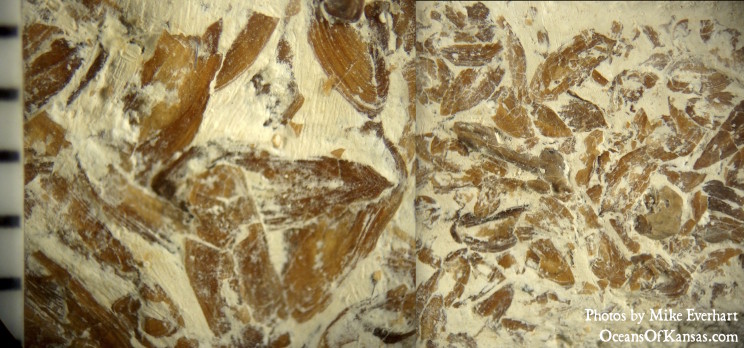
Cephalopods are an extremely important part of ocean food webs today, and the fossil record suggests that they might have been an even bigger player back in the cretaceous, as they appear to have filled some of the ecological space now filled by smaller fish.
Here’s a few more images of animals featured in this scene that I illustrated and designed for museum signage, plus a version of the bait-ball scene labeled with the names of all the other critters:

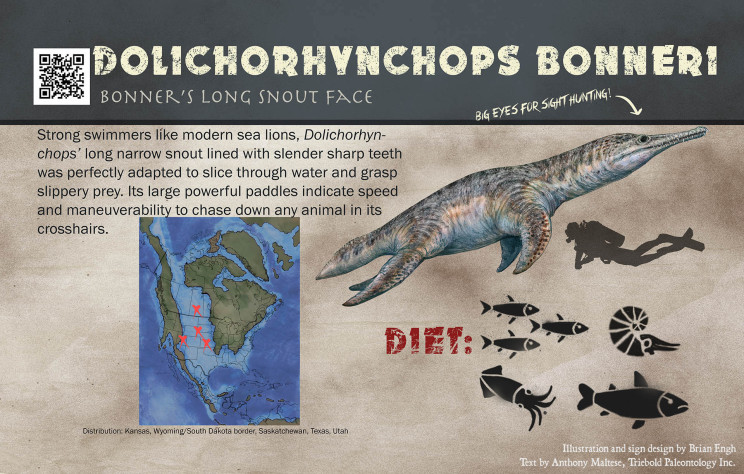
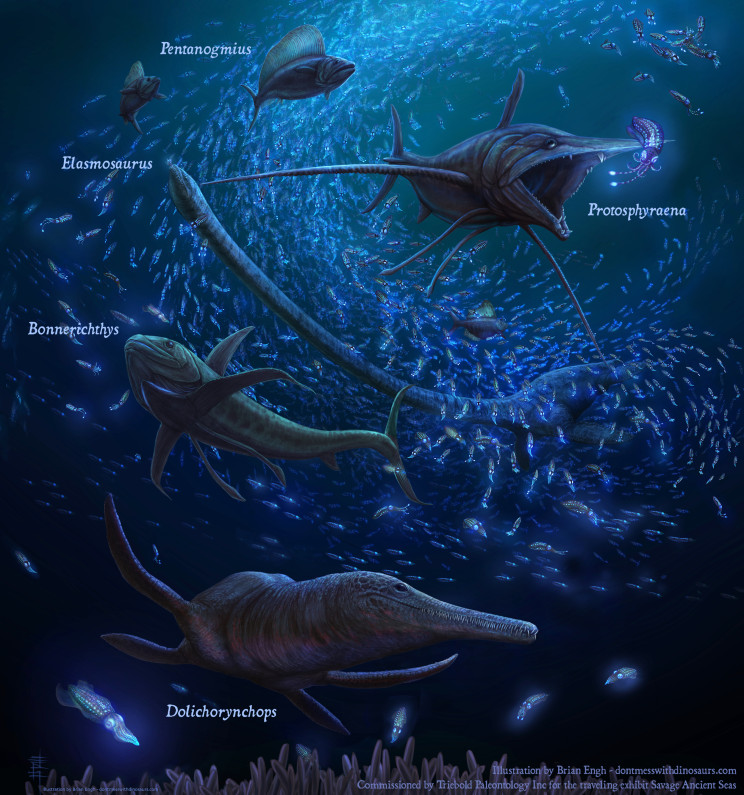
I owe a big thanks to Anthony Maltese and Mike Triebold for hiring me on to do the art for Savage Ancient Seas, and a big congratulations to Anthony and his co-authors for their detailed work on these strange fish. Prior to creating the artwork for the exhibit I hadn’t even heard about Pachychormids, but I grew up in and near the ocean, so I had a great time drawing from my personal experience and fascination with marine biology to breathe life into this exhibit. Although fish and cephalopods don’t get nearly as much love in paleontology as things like dinosaurs and cats with long teeth, they are really important players in the history of the planet, and their fossils give us huge insights into ecology, evolution and even our own origins. Also, marine animals can be really really pretty. I hope my art helps spark interest in these bizarre and fascinating denizens of the world’s oceans though time, so that more of our species might better understand and appreciate the marine ecosystems of our planet both past and present.
Want to see imagery of glowing breeding squid that directly inspired this art? Check out this video on firefly squid breeding aggregations in Japan, but imagine you’re looking at these with insanely sensitive marine predator night-vision:
https://www.nationalgeographic.org/video/firefly-squid-of-honshu/
